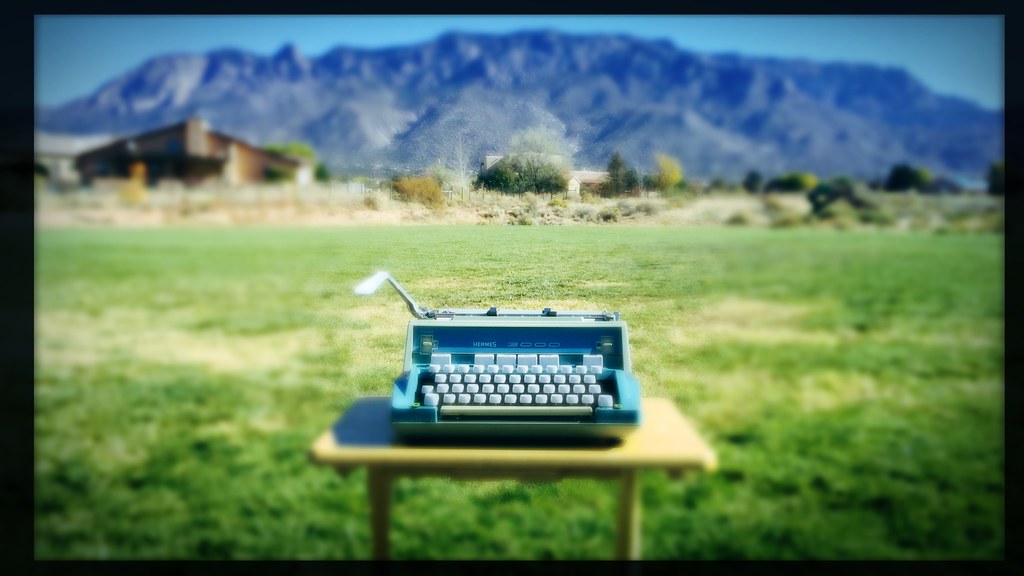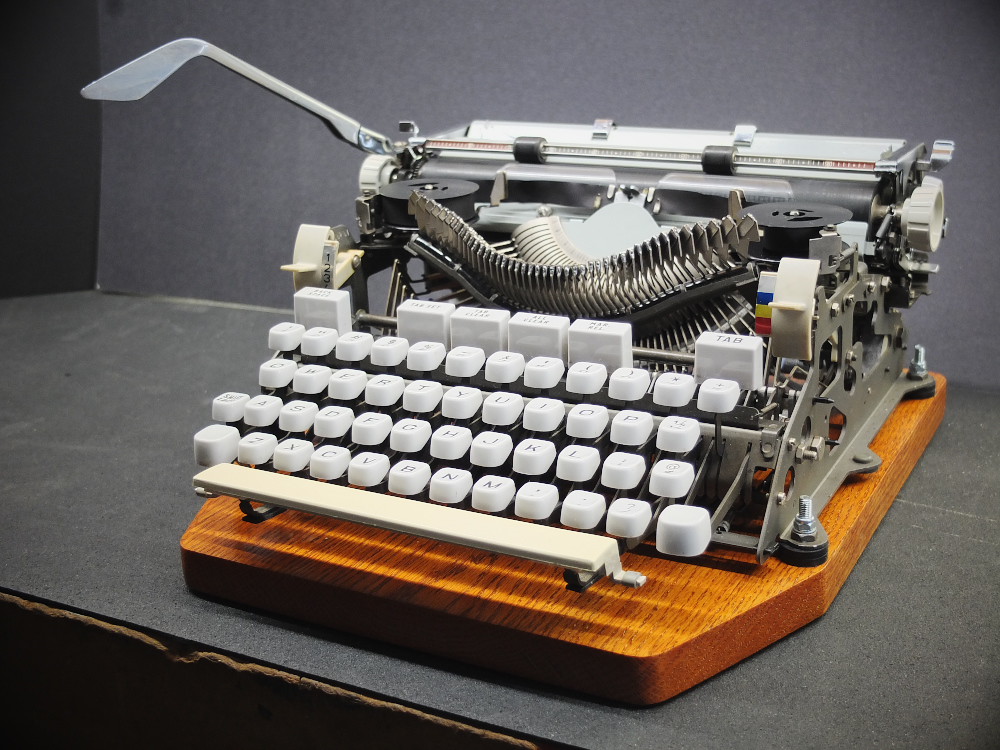The Cult of Hermes?


The mysterious thing about typewriters is the more you experience, the less certain you are about what might constitute the very best machine. Oh, for sure you know better than most the difference between the low-end and the high-end of the quality spectrum. And for certain, there’s lots of middle-of-the-road machines for whom excellence has not quite been achieved in either design or manufacture, but perhaps close enough, at least for some people.
The very best is a high bar to achieve - this is especially meaningful the more time you spend thinking about all the attributes of typewriters that you appreciate. For example, I had in my collection an Olympia SG3. For many, this would be considered near the apex of mechanical build quality. True enough, it’s hard to argue with that era of Olympia in terms of construction. To find a better-built machine you’re now in the rarified air of rank opinion more than absolute fact. And you still have to consider the condition of any one particular specimen.
But what if one attribute that signifies the best, like build quality, is diametrically opposed to other attributes, like portability? Or storability? The problem with the SG3 - for me - was that I didn’t have a permanent place to use it, since I live in a smaller house and store machines in closets when not in use. Full-sized office machines like the SG series don’t come with cases, meaning they’re not “portables” in any sense of the word. I also like to write in various venues and settings. These behemoths just aren’t compatible with that requirement, regardless of how well built they might be. My SG3 also had an extra-wide carriage which, because of its excess mass, meant the carriage return action was irritatingly heavy. Just enough to not be perfect.
Down on the ultra-portable end of the spectrum we find many machines very light and diminutive, easy to tote around in either their case or a messenger-style bag. But they often lack build quality, an expressive feedback touch and a full set of features. Design compromises must be made for the sake of portability.
Somewhere in the middle of the spectrum we might come closer to perfection, or its second-cousin, near-perfection, when we consider medium-sized portables, machines that technically can be lugged around in a case via a handle, but you wouldn’t be comfortable doing so for very long. They can be stored in the closet when not in use and usually come with a full set of features.
When we begin to consider the best of the medium portables there are a few brands and models that stand out, like the Smith-Corona 5 series, the Olympia SM series, the Royal QDL and the Hermes 3000. There are also many other brands and models, less easy to find, that might rank up close to this grouping. And when we begin to consider this elite group of machines, we find ourselves at odds with our own expectations. Like not being able to see the forest through the trees, or getting so close to the base of the mountain that the foothills obstruct the grand vista, so too do we find it difficult to choose just one model that’s the very best. At least for me. The royal “we.”
What if we say the Smith-Corona was the best? Then we’d have to discount the superior build quality of the Olympia, or the smoothness of the Hermes. They each have unique attributes that make them desirable, which is why they’re on the short list. It’s hard to be a monogamist here, with so many enticing machines.
And so we come to The Cult of Hermes. Even if you don’t hold the Hermes 3000 in that high of esteem, it’s hard to argue with The Cult of Hermes as a title. Sounds like The Cult of Diana, something out of ancient history, with mysterious rituals. Of course, this is all tongue-in-cheek. We imagine a Cult of Hermes because of the adoration and fanfare given to these machines by collectors, which have helped to drive up prices on the used market. What kind of Kool Aid does a person have to drink before they too are a True Believer?

Well, it took me giving the former Nekkid-Riter Hermes 3000 to my friend Kevin, before he had enough time to give the machine a fair shake. He’d been a skeptic too. Now, he’s closer to a true believer, if there is such a thing. As he told me, the 3000 just gets out of the way during the process of writing. You don’t notice it, the machine fades into the background, nothing about it stands out as an irritant or distraction. And it’s surprisingly quiet, even with a hard platen. It offers enough features to not be lacking for anything, other than perhaps a half-space feature.
Of course, we do keep our eyes on the other prized machines in the Pantheon of the Greats. We may be a Hermes cult member, but we’re also ecumenical enough to be curious about other cults, too. Lately, in fact, I’ve dipped my toe into the Cult of Olivetti. But that’s a tale for another day.
Of course, we do keep our eyes on the other prized machines in the Pantheon of the Greats. We may be a Hermes cult member, but we’re also ecumenical enough to be curious about other cults, too. Lately, in fact, I’ve dipped my toe into the Cult of Olivetti. But that’s a tale for another day.
Labels: Hermes 3000, typewriter collecting


7 Comments:
The first Pantheon, in Rome, was the home of many gods! Certainly the H3k would be in there, but what god would it be?
You need a signifying identifier? Stick a pair of wings to your shoes! Simples ;)
If theres any room for new members in the Cult Of Hermes, I’d like to submit an application. My all-time favorite typers are all Hermes made machines from 1938-1967. While I do own some other brands that are wonderful machines, something about the total package you get with a Hermes makes me keep coming back. Truly one of the highwater marks for the manual typewriter...
Count me a member. I got my first Hermes 3000 a few years ago, a 1961, then I bought a second, a 1967. And I just bought a third-- I think it's a 1963--as a backup, and for the beautiful distinct font. At first using a typewriter once in a while was just something fun, but for the past many months I have been using them every day. I find them immensely practical-- mainly for keeping me off the screens & the myriad time-wasting temptations of the Internet. Whatever I would prefer to have in machine-writing-- hence easier to read-- but that need not be copied nor shared I take to the Hermes. These machines can take a pounding! Mine were all made in French-speaking Switzerland.
Love the Nekkid-Writer!
What impresses me the most about Hermes (all models) is their precise alignment. It's evident in your typing sample: everything lines up with Swiss-watch-level precision. This is not easy to achieve, since a half-millimeter difference creates a really jarring disruption when you're reading text. Compare the work of a Royal, for instance, to that of a Hermes and you can see that other brands, no matter their virtues, did not achieve the same level of exactitude.
Cult status confirmed. I think you've settled nicely into the Goldilocks zone... not to big, not too small. Great looking typecast!
When I discovered the nascent Typosphere back in 2010, it was because I had just rekindled my interest in mechanical typewriters and was searching for a "better" typewriter than the 4 I had then already collected over the then past 15 years (a 1956 Silent, a 1948 QDL and two Remingtons that weren't in good operating state). The bloggers at that point were enthusing about the Hermes 3000 (the McMurtry auction had just happened, catapulting the H3k into superstardom), and so that very day I hit Craigslist and found a 1964 H3k locally for $50 - easiest quest ever!
It was then that I realized that the H3k wasn't "better", it was just different. I found that I enjoyed the different typing experiences offered by different machines, and so my T.A.S. was not satisfied. 10 years later now, and I'd be hard pressed to cull my collection down below 50 simply because it's not about what's "best", it's about what typing experience I want in the moment. (:
Post a Comment
<< Home